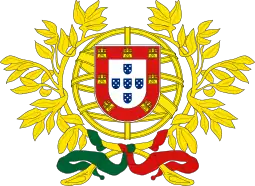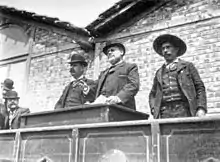1911 Portuguese Constituent National Assembly election
Constituent Assembly elections were held in Portugal on 28 May 1911, following a coup in October 1910.[1] The result was a victory for the Portuguese Republican Party, which won 229 of the 234 seats.[2]
| ||||||||||||||||
234 seats to the Chamber of Deputies 118 seats needed for a majority | ||||||||||||||||
|---|---|---|---|---|---|---|---|---|---|---|---|---|---|---|---|---|
| ||||||||||||||||
 | ||||||||||||||||
| ||||||||||||||||
 |
|---|
| This article is part of a series on the politics and government of Portugal |
| Constitution |
Electoral system
The country was divided into 51 constituencies for the election.[3] Lisbon elected 20 members from two 10 member seats using proportional representation and the d'Hondt method, whilst Oporto had one 10 member constituency using the same system.[3] The remaining seats were elected from 48 constituencies with three or four members.[3]
Property qualifications for voters were abolished and suffrage was extended to all adults who were either literate or heads of their households, as well as soldiers, who had previously been barred from voting.[4] Bankrupts and "vagabonds" were excluded from the electoral roll.[3]
Candidates for the election had to be literate, and could not run in more than one seat.[3] Party lists had to obtain a certain number of signatures in every constituency (100 in Lisbon and Oporto and 25 in other constituencies) in order to contest the election.[3]
Parties
The table below lists the parties that contested the elections:
| Name | Ideology | Political position | Leader | ||
|---|---|---|---|---|---|
| PRP | Portuguese Republican Party Partido Republicano Português |
Republicanism Radicalism |
Centre | Teófilo Braga | |
| PSP | Portuguese Socialist Party Partido Socialista Português |
Socialism Proudhonism |
Left-wing | Azedo Gneco | |
Results
| Party | Votes | % | Seats |
|---|---|---|---|
| Portuguese Republican Party | 229 | ||
| Portuguese Socialist Party | 2 | ||
| Other parties | 3 | ||
| Invalid/blank votes | – | – | |
| Total | 234 | ||
| Registered voters/turnout | 846,801 | – | |
| Source: Nohlen & Stöver | |||
Aftermath
The 1911 constitution was subsequently drawn up, which provided for a bicameral parliament and a president elected by a two-thirds vote in Parliament.[3]
References
- Dieter Nohlen & Philip Stöver (2010) Elections in Europe: A data handbook, p1542 ISBN 978-3-8329-5609-7
- Nohlen & Stöver, p1551
- Nohlen & Stöver, p1534
- Nohlen & Stöver, pp1533-1534
.jpg.webp)
